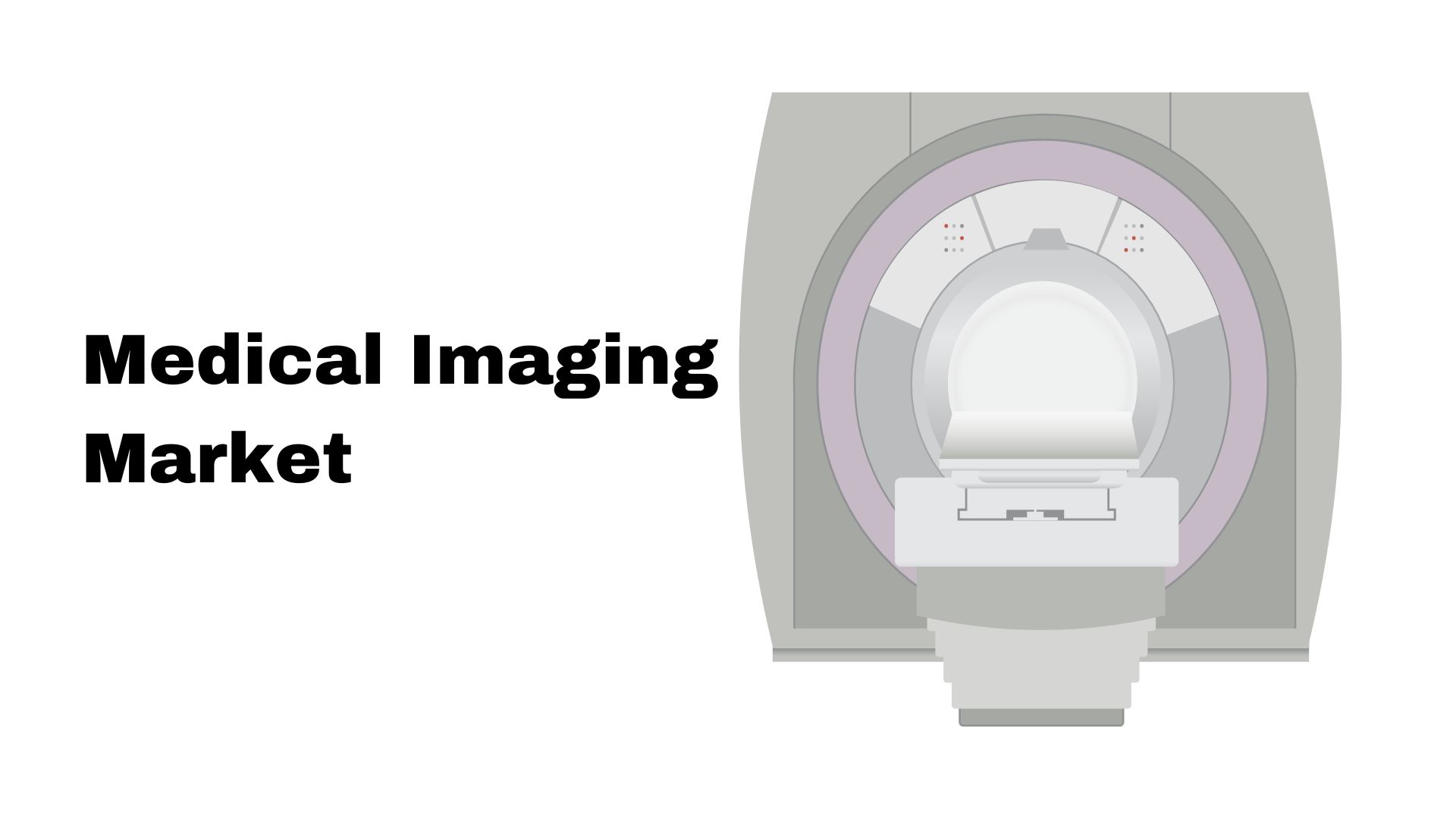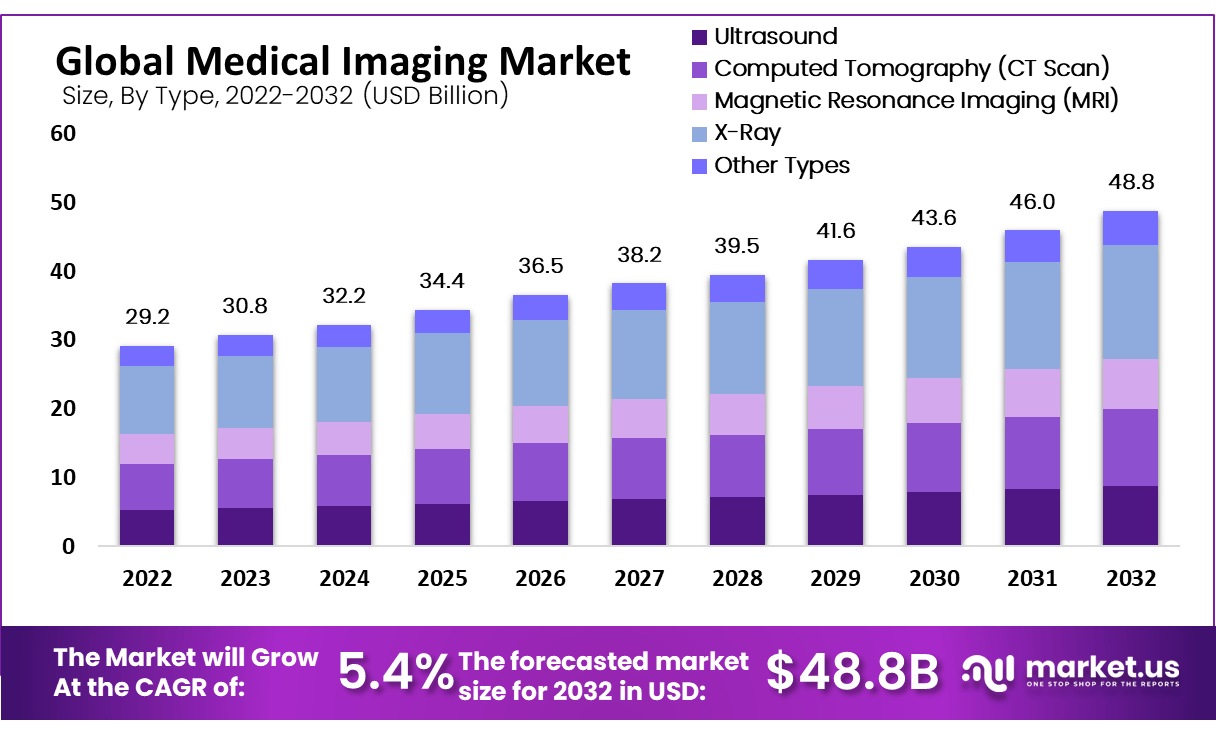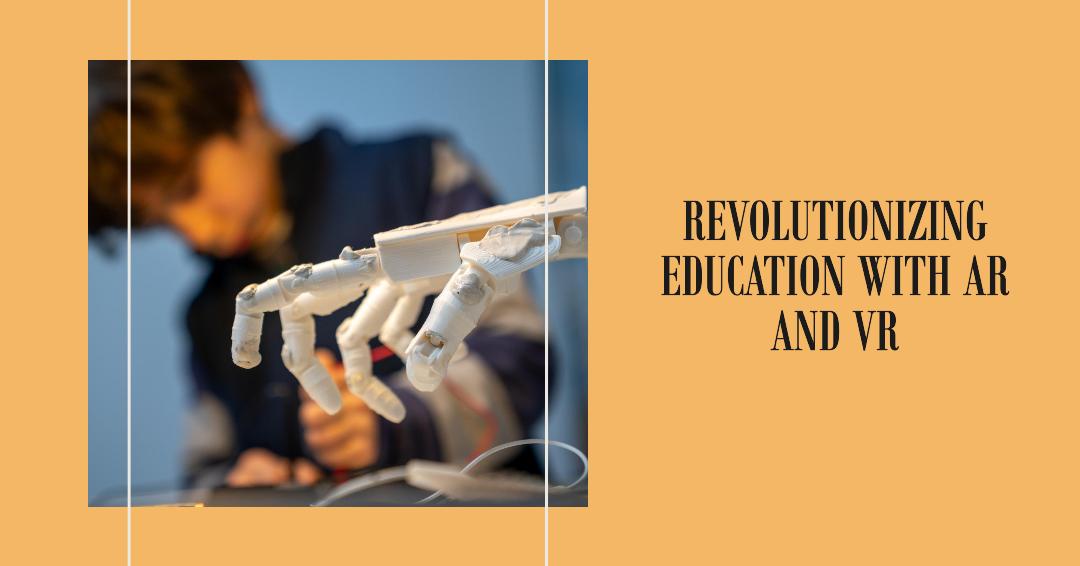Medical Imaging Market Size to hit USD 48.8 Billion, Globally, by 2032 | CAGR of 5.40%

Page Contents
Market Overview
Published Via 11Press : The medical imaging market is steadily growing, with an increase in demand for new and advanced technologies. This market includes various products such as X-ray systems, CT scanners, MRI machines, ultrasound systems, and nuclear medicine equipment.
The Medical Imaging Market size is USD 29.2 Billion in 2022 and is expected to be worth around USD 48.8 Billion by 2032, growing at a CAGR of 5.40% during the forecast period from 2023 to 2032.
One of the key drivers behind this growth is the increasing prevalence of chronic diseases such as cancer and cardiovascular disease that require accurate diagnosis through medical imaging techniques. Additionally, technological advancements have made it possible to develop more precise diagnostic tools that are less invasive and offer higher-resolution images.
North America currently dominates the medical imaging market due to a high number of healthcare facilities equipped with advanced machinery and a growing aging population requiring more frequent diagnostic procedures. However, Asia-Pacific is expected to experience significant growth due to increased healthcare spending and government initiatives aimed at improving healthcare infrastructure in countries like China and India.
Request For Sample Report Here: https://market.us/report/medical-imaging-market/request-sample/

Key Takeaway
- By Product Type, The X-ray industry was dominant within its respective market in 2022 with regard to revenue share and market presence.
- Orthopedic devices comprised the largest portion of global applications worldwide.
- By 2022, hospitals represented an increasingly larger share of revenue across all end-user markets.
- 2022 marked North America as being a key market, accounting for 36.0% of revenues and dominating all others worldwide.
- Asia-Pacific is expected to experience rapid economic expansion between 2023-2032.
Regional Snapshot
- North America: Imaging services have experienced rapid market development throughout North America and particularly in the US over recent decades, due to an expanding healthcare system with high health expenses, technological innovations, and an aging population with increasing healthcare needs. High-end imaging techniques like MRI, CT, and PET/CT imaging techniques are in high demand there and this development factored heavily into the growth of imaging services here.
- Europe: Europe has also witnessed the substantial expansion of medical imaging markets, led by countries like Germany, the United Kingdom, France, and Italy. Chronic illnesses coupled with government efforts to upgrade health infrastructure as well as technological solutions have all played a part in driving up demand across this region for this service.
- Asia Pacific: Medical imaging in Asia has experienced unprecedented growth over recent years. States such as China, India, Japan, and South Korea are all key market participants within this region due to increased infrastructure for healthcare provisioning as well as rising disposable income and spending rates among patients, thus fueling market development. With medical imaging being such an effective means for diagnosing as well as treatment planning disease is widespread throughout this area of development.
- Latin America: Latin America has experienced steady expansion within medical imaging in recent years. States such as Brazil, Mexico, and Argentina have played key roles in driving growth across this market region due to improvements to facilities as well as rising healthcare costs; an awareness of disease early detection also fuels this upward trajectory in demand across Latin America.
- Middle East and Africa: Medical imaging has seen tremendous growth throughout this part of the world, particularly in Saudi Arabia, UAE, and South Africa which have all played key roles. Health investments, infrastructure upgrades as well as chronic illness burden have all played major parts in contributing to its development in these regions.
AI Insights: Generative AI's Impact on Medical Imaging Market
Generative AI can be used to improve the quality, accuracy, and efficiency of medical imaging. For example, generative AI can be used to:
- Generate synthetic medical images: Generative AI can be used to generate synthetic medical images that are indistinguishable from real images. This can be used to train AI models for medical diagnosis and to create virtual patient populations for clinical trials.
- Improve image quality: Generative AI can be used to improve the quality of medical images by removing noise and artifacts. This can make it easier for radiologists to diagnose diseases.
- Automate image analysis: Generative AI can be used to automate the analysis of medical images. This can free up radiologists to focus on more complex cases.
- Personalize treatment: Generative AI can be used to personalize treatment by creating patient-specific models of disease progression. This can help doctors to develop more effective treatment plans.
Directly Purchase a copy of the report | Quick Delivery Available – buy: https://market.us/purchase-report/?report_id=11771
Drivers
- Increasing Prevalence of Chronic Diseases: The rising prevalence of chronic diseases, such as cancer, cardiovascular disorders, and neurological conditions, drives the demand for medical imaging. Imaging techniques are crucial for accurate diagnosis, treatment planning, and disease monitoring.
- Technological Advancements: Advances in medical imaging technologies, such as digital imaging, 3D imaging, molecular imaging, and artificial intelligence (AI)-assisted imaging, have improved the accuracy, speed, and efficiency of diagnostic procedures. Technological innovations drive the adoption of medical imaging equipment.
- Aging Population: The global aging population is increasing, leading to a higher incidence of age-related diseases and conditions. The elderly population requires frequent medical imaging for diagnosis and management, contributing to the demand for imaging equipment.
- Growing Demand for Non-Invasive Diagnosis: Medical imaging provides non-invasive or minimally invasive diagnostic capabilities, reducing the need for more invasive procedures. This demand for non-invasive diagnosis and patient comfort fuels the growth of the medical imaging market.
- Increasing Healthcare Expenditure: The overall growth in healthcare expenditure and investments in healthcare infrastructure contribute to the expansion of the medical imaging market. Governments and private entities allocate funds for the procurement of advanced medical imaging equipment and facilities.
Restraints
- High Cost of Equipment: The high cost of medical imaging equipment, including acquisition, installation, and maintenance expenses, can be a significant restraint. The high initial investment required for advanced imaging technologies may limit their adoption, particularly in resource-constrained healthcare settings.
- Regulatory Challenges: Medical imaging equipment is subject to strict regulatory requirements and quality standards. Obtaining regulatory approvals and compliance with evolving regulations can pose challenges for manufacturers, impacting product launches and market entry.
- Radiation Exposure Concerns: Certain medical imaging modalities, such as X-ray and CT scans, involve exposure to ionizing radiation. Concerns about radiation exposure and its potential health risks may influence patient and healthcare provider preferences and decisions regarding imaging procedures.
Opportunities
- Emerging Markets: Emerging markets, particularly in Asia Pacific, Latin America, and Africa, offer significant growth opportunities for the medical imaging market. Expanding healthcare infrastructure, increasing healthcare spending, and a growing patient population in these regions drive the demand for medical imaging equipment.
- Advancements in Artificial Intelligence (AI): The integration of AI and machine learning in medical imaging holds great potential for enhancing diagnostic accuracy, improving workflow efficiency, and enabling personalized medicine. AI-assisted imaging techniques and software solutions create new opportunities for market growth.
- Point-of-Care Imaging: The shift toward point-of-care imaging, which allows medical imaging to be conducted directly at the patient's bedside or in clinics, presents opportunities for portable and compact imaging devices. Point-of-care imaging offers convenience, reduces wait times, and improves access to imaging services, particularly in remote or underserved areas.
Challenges
- Data Security and Privacy Concerns: Medical imaging generates large volumes of patient data that need to be stored, processed, and transmitted securely. Ensuring data security, privacy, and compliance with regulations, such as HIPAA, presents challenges for healthcare providers and imaging equipment manufacturers.
- Limited Reimbursement: Reimbursement policies and coverage for medical imaging procedures vary across healthcare systems and insurance providers. Limited reimbursement for certain imaging procedures or restrictions on coverage may impact the utilization and adoption of advanced imaging technologies.
- Equipment Obsolescence: Rapid technological advancements in medical imaging can lead to equipment obsolescence. Healthcare providers need to carefully plan equipment replacements and upgrades to ensure compatibility with newer technologies and avoid financial burdens.
Make an inquiry before picking up this report @ https://market.us/report/medical-imaging-market/#inquiry
Key Market Players
- FUJIFILM VisualSonics Inc.
- Koninklijke Philips N.V.
- Siemens Healthcare GmbH
- Mindray Medical International Ltd
- Hologic, Inc.
- Canon Medical Systems Corporation
- Samsung Medison Co., Ltd.
- Cubresa Inc.
- Esaote SpA
- Other Key Players
Key Market Segments
Based on Type
- Ultrasound
- Computed Tomography (CT Scan)
- Magnetic Resonance Imaging (MRI)
- X-Ray
- Other Types
Based on Applications
- Orthopedics
- Neurology
- Cardiology
- Oncology
- Gynecology
- Other Applications
Based on End-User
- Hospitals
- Diagnostic Imaging Centers
- Specialty Clinics
- Other End-Users
Top Impacting Factors
- Rising Prevalence of Chronic Diseases: The increasing prevalence of chronic diseases, including cardiovascular disorders, cancer, and neurological conditions, has driven the demand for medical imaging. Imaging techniques play a crucial role in the early detection, diagnosis, treatment planning, and monitoring of these diseases.
- Aging Population and Healthcare Expenditure: The global aging population has led to a higher incidence of age-related diseases and conditions, boosting the demand for medical imaging services. Increased healthcare expenditure, especially in developed countries, supports the adoption of advanced imaging technologies and facilities.
- Growing Importance of Early Diagnosis and Preventive Healthcare: There is a growing emphasis on early diagnosis and preventive healthcare to improve patient outcomes and reduce healthcare costs. Medical imaging plays a critical role in the early detection of diseases, enabling timely interventions and personalized treatment plans.
- Shift towards Minimally Invasive Procedures: The increasing preference for minimally invasive procedures has driven the demand for imaging technologies that aid in accurate and real-time visualization during surgeries or interventions. Imaging modalities such as fluoroscopy, ultrasound, and intraoperative imaging are essential in guiding minimally invasive procedures.
- Integration of Artificial Intelligence (AI) in Medical Imaging: The integration of AI and machine learning algorithms in medical imaging has the potential to enhance diagnostic accuracy, improve workflow efficiency, and assist in clinical decision-making. AI-enabled applications in medical imaging, including image analysis, pattern recognition, and automated reporting, are transforming the market.
- Regulatory Environment and Reimbursement Policies: The medical imaging market is subject to strict regulatory requirements, including safety standards and product approvals. Compliance with regulations and obtaining necessary certifications is crucial for market entry. Additionally, reimbursement policies and coverage for medical imaging procedures impact the market dynamics.
Recent Developments
- In April 2022, The next-generation Revolution Aspire CT scanner was launched by Wipro GE Healthcare. It is an advanced imaging solution that is manufactured and designed end-to-end in India.
- In July 2022, The Vantage Fortain MRI System at ECR 2022 was launched by Canon Medical. This MRI system features innovative workflow solutions, accelerated scan technology, and image enhancements, which together contribute to reducing the time required for MRI.
Report Scope
| Report Attribute | Details |
| The market size value in 2022 | USD 29.2 Bn |
| Revenue Forecast by 2032 | USD 48.8 Bn |
| Growth Rate | CAGR Of 5.40% |
| Regions Covered | North America, Europe, Asia Pacific, Latin America, and Middle East & Africa, and Rest of the World |
| Historical Years | 2017-2022 |
| Base Year | 2022 |
| Estimated Year | 2023 |
| Short-Term Projection Year | 2028 |
| Long-Term Projected Year | 2032 |
Frequently Asked Questions
Q: What is the current size of the Medical Imaging Market?
A: The Global Medical Imaging Market size is USD 29.2 Bn in 2022.
Q: What is the projected growth rate for Medical Imaging Market?
A: The Medical Imaging Market is expected to grow at a CAGR of 5.40% from 2023 to 2032.
Q: What are some of the key players in the Medical Imaging Market?
A: Some of the key players in the Medical Imaging Market include FUJIFILM VisualSonics Inc., Koninklijke Philips N.V., Siemens Healthcare GmbH, Mindray Medical International Ltd, Hologic, Inc., Canon Medical Systems Corporation, Samsung Medison Co., Ltd., Cubresa Inc., Esaote SpA, Other Key Players.
Contact:
Global Business Development Team – Market.us
Market.us (Powered by Prudour Pvt. Ltd.)
Send Email: [email protected]
Address: 420 Lexington Avenue, Suite 300 New York City, NY 10170, United States
Tel: +1 718 618 4351
Website: https://market.us
Content has been published via 11press. for more details please contact at [email protected]
The team behind market.us, marketresearch.biz, market.biz and more. Our purpose is to keep our customers ahead of the game with regard to the markets. They may fluctuate up or down, but we will help you to stay ahead of the curve in these market fluctuations. Our consistent growth and ability to deliver in-depth analyses and market insight has engaged genuine market players. They have faith in us to offer the data and information they require to make balanced and decisive marketing decisions.



